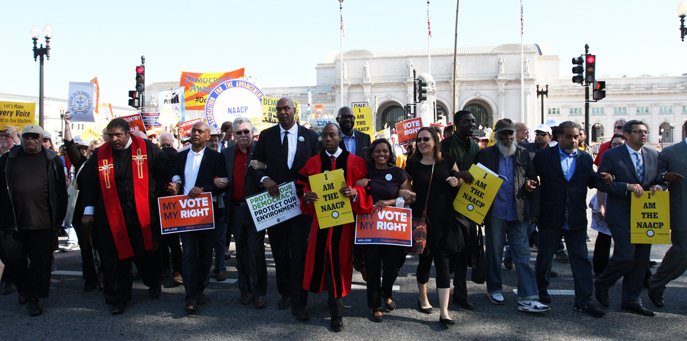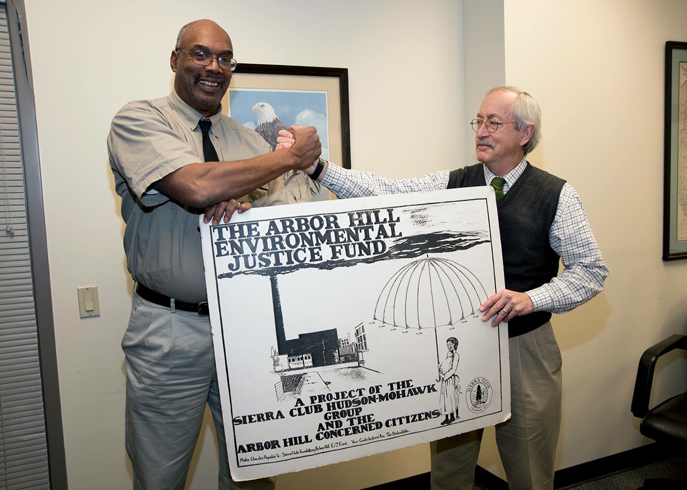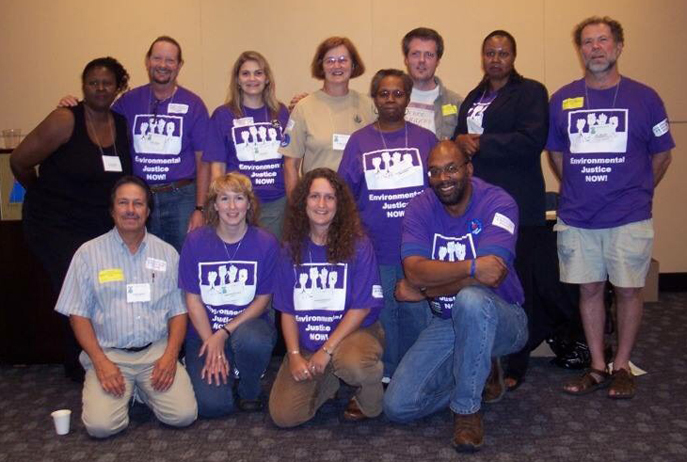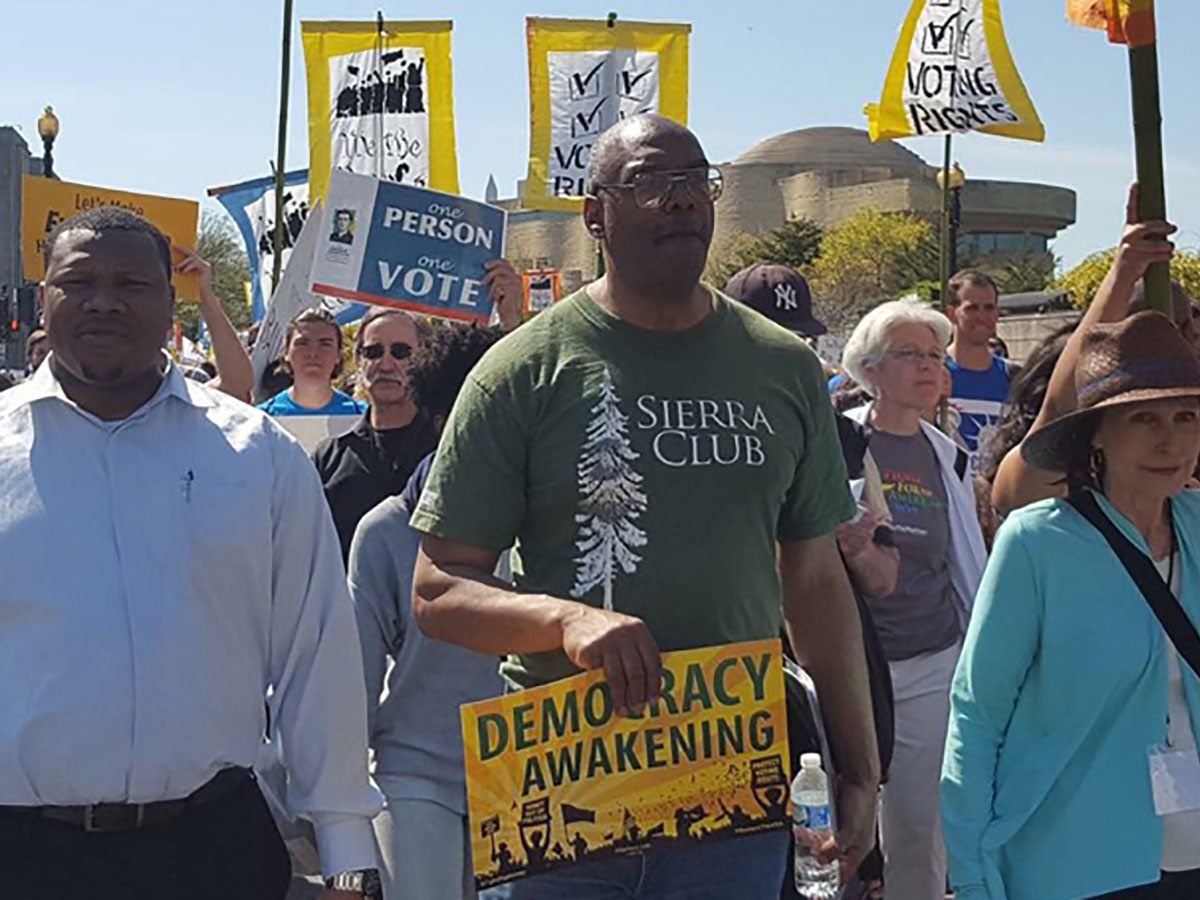In kicking off this 125th anniversary of the Sierra Club, I think it’s important as the organization’s first African American president, and only the second Sierra Club president of color (Allison Chin, who served from 2008-2010 and 2012-2013, was the first), to highlight how key the Sierra Club has been in transforming the environmental movement and the conversation about human stewardship of the planet.
The Club is evolving away from what scholars like Wendell Berry would describe as the “terrarium view” (or the “sanctity of nature” perspective) or “environmental protection society” approach with a conservationist thesis in an inherent right of nature without humanity that marginalized or disregards social, cultural, and “human heritage” interactions as key aspects of environmental stewardship, and toward a more diverse, inclusive, and welcoming environmental culture. These 19th and early 20th century approaches to conservation did not protect of include the rights of indigenous peoples or cultures that were connected to the land. Thanks to Berry’s works like “The Unsettling of America: Culture & Agriculture” and “The Hidden Wound”, which explores how the very democratic institutions and American social structures have degraded both humanity and the environment, modern-day environmentalists can understand how race and politics have shaped institutional power, culture, and the environmental movement.
The Sierra Club has come a long way from the naturalist polygenetic theory espoused by Louis Agassiz, which shaped and influenced his student and protege, Joseph LeConte. This narrow and specialized view of the naturalized world “without man” would come to be challenged by scholars like Wendell Berry and influenced movements that like the early Earth Day celebrations in the 1970s. Rachel Carson's book, "Silent Spring" touched off a global conversation on the dramatic impacts of agriculture and the industrialized use of pesticides on the environment. This awakening within developed nations, of society’s impact on the environment, sounded a powerful call for action that culminated in the Earth Day movement.
Unfortunately, the conversation around population growth and its impact on the planet often focused on high birth rates in low-income communities and in “developing” non-white nations. Few Sierrans realize that race, population eugenics, and “natural order” were critical features and values of our founders and naturalist societies of the late 19th and 20th centuries, which largely blamed environmental degradation on developing and non-European populations. The proverbial “wound” or foundation of environmental racism and exclusion begin with our founding naturalists, who were also pioneers in the eugenic classifications of humanity.
“The wound of racism has resulted inevitably in wounds in the land, the country itself,” Wendell Berry posits. In short, there is no wall of separation between America’s rich environmental legacy and national attitudes about race, culture, and political policies that marginalize minorities.
Berry raises the powerful point that environmentalists, farmers, agribusiness interests, and governing, regulatory, and academic institutions like land grant colleges have removed the sacred human connection with -- and dependency upon -- the land from true environmental stewardship and replaced it with industrial-scale exploitation of both land and humanity. One of the evils of this dangerous social process is “specialization,” a form of human alienation that reduces land and humanity to mere vehicles of labor, production, and capital that are depleted and exhausted for profit. This notion of specialization “saves” small patches of the wild without taking into account humanity or recognizing the human role in nature.
What does this have to do with the environmental and “justice” movements, one may ask. The answer is: Everything -- especially if we are to “enlist all humanity to save the planet.” It was not until Earth Day in1970 -- nearly eight decades after the Sierra Club’s founding -- that environmentalism per se arose in response to the crises of and pollution and environmental degradation. It was from the visibly deteriorating plight of humanity and the damage being done to the planet itself -- such the Cuyahoga River in downtown Cleveland catching on fire -- that this “radical” notion of stewardship was born.
The tactics of mobilizing and organizing for mass action that prompted political action like passage of the Clean Air & Clean Water Acts grew out of the Civil Rights movement, and borrowed heavily from it. Today, environmentalists have many opportunities for action and leadership -- and while they remain important, not just the traditional wilderness protection, land conservation, and outings. Modern-day environmental issues such as climate disruption, toxics, agriculture, transportation, sprawl are just a few key issues that would have been utterly foreign to Joseph LeConte, John Muir, and the early Sierra Club.
I would take issue with anyone who suggests that the Sierra Club has “gone too far” by meeting these more recent environmental challenges, as I would with those who believe we should abandon our broadening of the Club’s internal culture by striving to become a more diverse, equitable, just and inclusive organization. Critical to our work is having a democracy and representative government that works to protect the environment for all Americans. The same politician who blocks citizens’ voting rights is all too often the same politician who leverages Citizens United’s excessive corporate largesse to elect other politicians who are committed to rolling back decades of good environmental policy and protections. The dynamics of race, political power, and wealth have been used to disempower and deny Americans of color from equally sharing, shaping, and benefitting from our country’s environmental heritage.

Democracy Awakening rally
What does that have to do with the Sierra Club? Few realize that in 1892 -- the very year he helped found the Sierra Club -- LeConte published an “analysis” of “inferior races” in general and blacks in particular in his book, The Race Problem in The South, in which he wrote:
“The laws determining the effects of contact of species, races, varieties, etc., among animals may be summed up under the formula: The struggle for life and the survival of the fittest. It is vain to deny that the same law is applicable to the races of man also. Given two races widely diverse in intellectual and moral elevation, and especially in capacity for self-government, i.e., in grade of race evolution; place them together in equal numbers and under such conditions that they cannot get away from one another, and leave them to work out for themselves as best they can the problem of social organization, and the inevitable result will be, must be, ought to be, that the higher race will assume control and determine the policy of the community. Not only is this result inevitable, but it is the best result for both races, especially for the lower race…”
LeConte’s personal and academic philosophy and theories help shaped our young nation’s views on race, power, values, and the environment. It was not until the publication in 1987 of Toxic Waste and Race in The United States by the United Church of Christ, and Wendell Berry’s 1989 book Shades of Darkness, that America’s true environmental legacy was explicitly laid out, and activists, scholars, corporations, and environmentalists were able to fully grasp the intersectionality of race and environmentalism. America’s policies of “separate but unequal” played out in this space, with devastating consequences for all of humanity. It is thanks to the Church of Christ’s scientific analysis and Berry’s cultural critiques that we now possess the language and the tools to recognize how corporate land use policies, permitting, and legal loopholes for projects like the Dakota Access Pipeline violate the Standing Rock Sioux National people’s sacred connection to their land and water.
When we look back over the first century of the American environmental movement as it relates to land use by Native Americans, blacks,and Hispanics, we can see the dominance of LeConte’s white supremacist notion of exploitative land use and for-profit recreation. All one need do is visit South Dakota’s Black Hills, long held sacred to the Lakota People, and ponder the edifice of Mount Rushmore, where a monument glorifying four great American presidents who are also “in-your-face” symbols of occupying conquerors, has been hewn into the living rock.
We can also look at the displacement and near-total eradication of the Gullah (West African English patois-speaking) people from Carolina barrier islands like Daufuskie by developers, and contrast that with David Brower’s successful efforts to save Cumberland Island off the coast of Georgia -- where there were no Gullah residents -- from similar development. The main difference is what was deemed sacred in each of these settings. What these important environmental symbols have in common is a democracy that failed to include and protect the culture, customs, and environmental heritage of African Americans and indigenous Americans.
It was the historic legacy of unequal environmental protection, and the absence -- some would say the exclusion -- of people and perspectives of color from America’s otherwise proud environmental legacy, that gave rise to the national environmental justice movement in the 1980s. While Mother Earth and the environment recognize no racial distinctions, the foundational democracy of the United States has proved not to be color blind, and has in fact systematically created institutions that exclude people of color and the poor. It wasn't until the National Urban League and the Sierra Club co-sponsored the pioneering “City Care: A Conference on the Urban Environment” in 1979 that the Club began to have a conversation about how to engage communities of color in environmental policies that were affecting urban and rural areas alike. This revolutionary conference was attended by 700 activists from all over the United States, and marked what would become a long-term commitment to engage citizens of color and incorporate diverse perspectives into the environmental movement.
It was at this conference that communities of color became convinced that organizations like the Sierra Club would be reluctant to address “non-traditional” environmental issues issues that didn’t exist for the late-19th and early 20th century Sierra Club such as toxics, air and groundwater pollution, and a range of other issues that disproportionately affected low-income communities and communities of color.
Undeterred, Sierra Club leaders like Darryl Malek-Wiley on the Gulf Coast were on the ground in the 1980s to help Cancer Alley activists in Louisiana mobilize to protect their communities from the massive and metastasizing petrol-chemical industry. Darryl personified the cause of inclusion and justice by elevating those communities of color who were powerless to fight against the toxics by making sure that their grievances and concerns and the harm done to them were heard by the world.
I became involved in the environmental justice movement in the late 1980s due to the siting of an eight-county regional waste shed garbage incinerator in my Albany, NY, community of Arbor Hill. I personally sought the assistance of the Sierra Club in our environmental struggle, but I failed to gain the support of the Club’s Atlantic Chapter. (It was common at that time for minority communities not to receive the support of the Sierra Club.) My community did get a token commitment of support from the Hudson Mohawk Group of the chapter that prompted me to eventually join the Club so that I could help transform the organization from within and nudge it in the direction of becoming a more inclusive organization.

Mair with Roger Gray of the Atlantic Chapter's Hudson Mohawk Group
My formal membership with the Club was not cemented until nine years after the milestone and historic Southwest Organizing Project (SWOP) letter calling for the “Big 10” environmental organizations (Sierra Club, Audubon Society, National Wildlife Federation, Nature Conservancy, Natural Resources Defense Council, Environmental Defense Fund, National Audubon Society, Wilderness Society, National Parks Conservation Association, and Friends of the Earth) to incorporate the perspectives of communities of color and indigenous nations into their agenda and their policy-making, treat them equally, and end the elitist practices that had held sway for so many decades. In short, if these environmental organizations purported to speak to the nations of the world on behalf of the environment, they had to include diverse perspectives from all of humanity, not just a middle-class Eurocentric perspective.
That national demand in 1990 for inclusion by minorities, who called upon the Sierra Club to radically revise and update its vision, which had long dominated the environmental movement, was strikingly similar to the call issued by Wendell Berry to put human values, cultures, and connections back into environmentalism. The following year witnessed the historic gathering of poor rural whites, minorities, and indigenous North Americans coming together for the “National People of Color Environmental Leadership Summit” in Washington, D.C. This summit marked a huge challenge, and a huge internal transformation for the environmental movement. The coming together of rural Appalachian victims of coal extraction; asthmatics from New York City; Native Americans battling uranium, coal, and gas extraction; communities in the deep South reeling from PCB landfills, petrochemical production, and disposal; to organize, build on, and expand the environmental movement.
Within three years of the SWOP letter, the tireless work of a coalition of environmental justice leaders resulted in President Bill Clinton's pledge to issue an Executive Order on environmental justice and create the EPA’s National Environmental Justice Advisory Council. These actions by Clinton were historic and significant: For the first time, Title VI of the Civil Rights Act -- which “prohibits recipient practices that have the effect, however inadvertent, of discriminating on the basis of race, color, or national origin” -- was being applied to environmental policy. For the first time, our nation had a formal articulation of clean air, water, and soil as a civil right for all Americans.
During this period, the Sierra Club was divided into regional committees, and it was Jim Price of the Gulf Coast Regional Conservation Committee (GCRCC) that led the Club’s effort and conversation on the issue of environmental justice. Scott Douglas was the first African American EJ Organizer hired by the Sierra Club to cover GCRC five state areas serving chapters, groups, and local community environmental justice efforts. Despite being severely understaffed with limited support, GCRC staff and volunteers were key in building critical networks and relationships for the Sierra Club.
In the early 1990s, Leslie Fields, an attorney with the Texas Legislative Council in Austin, started working with the Texas NAACP and the Club’s Lone Star Chapter on EJ issues. She drafted farmworker health and safety laws and worked on redistricting. In this way, she spent a great deal of time in Texas learning about communities' issues with environmental racism and their lack of political representation and disenfranchisement. She convinced the Lone Star Chapter to add EJ to their slate of issues and joined the chapter as the EJ Director from 1995-1998. In this capacity, she pursued EJ and provided critical momentum to the nascent EJ by identifying and supporting leaders of color in the environmental arena in Texas and around the country.
In 1999, the Sierra Club received a multi-year grant to fund the establishment of an Environmental Justice Program and open five EJ offices around the country. Rita Harris, a well-known toxics activist in Memphis, Tennessee, was selected to staff the first of the five program sites in Memphis. The second program site to be established was in Washington, D.C., with Julie Eisenhart hired to lead EJ efforts there. Next came Rhonda Anderson, hired to lead the Detroit program site, and Flagstaff, Arizona, led by Andy Bessler. A fifth EJ office in Los Angeles was short-lived, and a program site in Appalachia, led by Bill Price, was established instead after a year-long series of listening sessions. EJ program sites were subsequently opened in New Orleans, led by Malek-Wiley, and in Minneapolis, led by Karen Monahan.
Meanwhile, Fields went on to serve as an executive director of Communities for a Better Environment in California; the International Director of Friends of the Earth US; consulted with NRDC and Earthjustice (among other gigs); and has been an adjunct law professor at Howard University School of Law. She became the director of the Environmental Justice and Community Partnerships Program at the Sierra Club in Washington DC in 2007.

Sierra Club Environmental Justice Committee at Project Renewal gathering in San Francisco.
My own environmental activism began in earnest in the early 1990s, working with local activists in Albany to shut down the polluting incinerator. In 1994 our litigation prevailed, and the settlement monies were invested in the creation of two environmental justice entities that built the capacity of the community to defend itself from future environmental injustices. After that, I made good on my promise to the Hudson Mohawk Group and joined the Sierra Club, where I served on the national Environmental Justice Committee, and worked with dozens of national leaders, staff, and volunteer activists to raise funds and grow the Club’s fledgling EJ program.
The biggest drawback for the Club’s EJ program was a not a lack of commitment on behalf of its volunteers, but the ‘brick wall” of a culture that still viewed the environmental concerns of minorities and indigenous people as social justice issues with little or no environmental context or ramifications. The fact is, the conditions of humanity, no matter how we try to compartmentalize them by race or socioeconomic status, are -- as Wendell Berry would assert -- inextricably connected with the health of our environment. You cannot protect the environment while failing to protect humanity.
The Sierra Club remains committed to this work and continues to make progress in our journey. A few examples of the significant strides we have taken over the last decade-plus:
- We adopted a diversity statement;
- We have created and offer in-house Dismantling Racism and cultural competency trainings;
- We helped support the creation of and have formally recognized a chapter in Puerto Rico;
- The Board of Directors adopted an Equity, Inclusion, and Justice multi-year plan, the key goals of which have been incorporated into the Club’s overall strategic plan;
- We have created a Department of Equity, Inclusion and Justice.
While we are proud of the progress we have made on this journey, we recognize we have a long way to go. We are dedicated to becoming an organization in which equity, inclusion, and justice are central and intrinsic to our work and help define who we are. Our commitment to advancing economic, racial, social, and environmental justice has never been stronger.
I am proud to have been part of a movement and a coalition that challenged the Sierra Club to truly enlist humanity and incorporate the perspectives of all peoples. I am deeply honored to be a president who has helped promote our new values of inclusion, equity, and justice that help the Club build on its own legacy while creating a welcoming space for 21st century activism. Happy Birthday Sierra Club! We have become a deeper shade of green.
